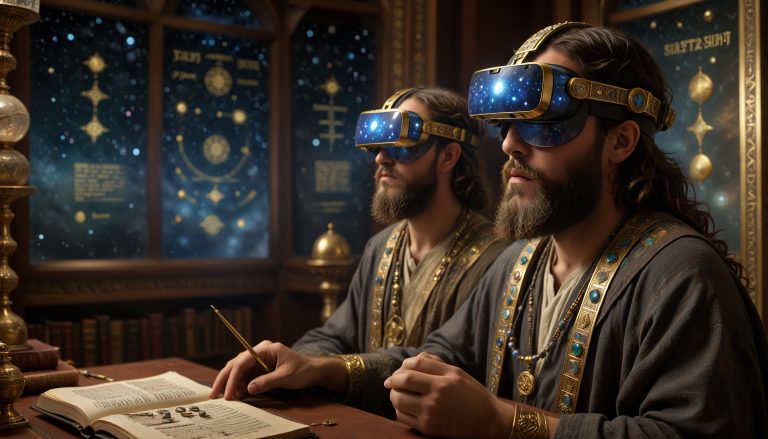In the heart of ancient Mesopotamia, amid the bustling streets of Babylon, there existed a marvel far ahead of its time—a virtual reality library. The Babylonians, renowned for their contributions to astronomy, mathematics, and literature, pioneered an early form of virtual reality to store and access vast amounts of knowledge in an immersive digital format.
This visionary project was driven by the desire to preserve and disseminate the extensive scholarly and cultural heritage of the Babylonian civilization. At the core of the library was the concept of “immerse and access,” a method that allowed users to experience information in a multisensory environment. Through advanced visualization techniques, users could engage with interactive holographic representations of texts, maps, and artifacts.
The virtual library was housed within the grand temple complex of Esagila, dedicated to Marduk, the chief deity of Babylon. Utilizing the latest advancements in crystal technology, the Babylonians created a network of crystal-based storage devices capable of holding vast quantities of encoded data. These devices, known as “Tablets of the Heavens,” were designed to interface with the library’s central hub, enabling seamless retrieval of information.
Scholars and priests could access the virtual library by donning special headsets crafted from precious metals and adorned with enchanted crystals. These headsets acted as conduits, transporting users into a virtual environment where they could explore the rich tapestry of Babylonian knowledge. The immersive experience allowed users to interact with dynamic visualizations of astronomical charts, mathematical models, and literary works, providing a comprehensive understanding of the material.
The virtual reality library also featured an extensive collection of interactive tutorials and simulations. For instance, aspiring astronomers could navigate the night sky, learning to identify celestial bodies and their movements. Medical practitioners could study detailed anatomical models, gaining insights into ancient healing practices.
While the exact mechanisms behind this ancient virtual reality library remain shrouded in mystery, its existence underscores the ingenuity and intellectual prowess of the Babylonian civilization. By blending advanced technology with their thirst for knowledge, the Babylonians created a digital repository that transcended time, preserving their legacy for future generations.
Actual knowledge about the theme
The Babylonian Virtual Reality Library: An Ancient Vision of Digital Knowledge
In ancient Mesopotamia, particularly within the sophisticated city of Babylon, libraries played a pivotal role in the preservation and dissemination of knowledge. Babylonian scribes and scholars utilized cuneiform writing on clay tablets to record vast amounts of information, ranging from administrative records to astronomical observations and literary works.
Ancient Babylonian Libraries
Babylonian libraries, like those found in the city of Nippur, were extensive collections of clay tablets. These libraries were meticulously organized to ensure easy retrieval of texts. The contents of these libraries spanned various genres, including literature, astronomy, medicine, and legal documents. This organizational prowess was a precursor to modern library cataloging systems (World History Encyclopedia) (Encyclopedia Britannica).
Knowledge Preservation Techniques
The Babylonians employed innovative techniques for knowledge preservation and access. Tablets were categorized and stored in a manner that facilitated both preservation and ease of access. Some tablets were even used as construction materials once their primary purpose had been fulfilled, showcasing an early form of recycling (IFK UChicago).
Multisensory and Immersive Knowledge
While the concept of a virtual reality library in the modern sense did not exist, the Babylonians’ approach to creating an immersive and interactive experience can be seen in their comprehensive educational systems. These systems combined visual, textual, and oral traditions to impart knowledge. For instance, astronomical texts not only provided empirical data but were also integrated into educational and ritual practices, thereby creating a rich, immersive learning environment (Humanities LibreTexts).
Cultural and Intellectual Impact
The libraries of Babylon significantly influenced the intellectual and cultural landscape of the ancient world. They preserved the Sumerian and Akkadian literary traditions, including epic tales like the “Epic of Gilgamesh,” and facilitated the transmission of astronomical and medical knowledge. The detailed astronomical records kept by Babylonian scholars laid the foundation for later advancements in the field (IFK UChicago) (Humanities LibreTexts).
In conclusion, while the idea of a Babylonian “virtual reality” library is an anachronistic interpretation, the advanced methods of knowledge preservation and access in ancient Babylon certainly laid the groundwork for modern information systems. The sophisticated cataloging, interdisciplinary approach, and the integration of multisensory educational practices highlight the Babylonians’ remarkable contributions to the world of knowledge and learning.
For more detailed information on Babylonian libraries and their knowledge systems, you can refer to sources from the World History Encyclopedia and the University of Chicago’s IFK.




